Four Yogas
This description of yoga, scribed 5,000+ years ago, is represented as an entire system which provides a lifestyle for day-to-day action and awareness. The practice of these four yogas—jnana-yoga, karma-yoga, dhyāna-yoga, and bhakti-yoga—is a continuously evolving journey which takes us to what is considered to be the highest practice of yoga in the Bhagavad Gita: bhakti-yoga.
Jnana-yoga
The word ‘jnana’ means knowledge. Jnana-yoga is defined in the Bhagavad Gita Essentials as, ‘The path of external renunciation, where outside activity is given up in pursuit of inner enquiry.’ The goal of the jnana yogi is to disentangle themself from the bondage of the material self through the process of renunciation and introspection. Through this contemplation and analysis, they learn to break their identification with body and mind to realise the Truth.
Jnana-yoga is a method to gain self-knowledge (Brahma-jnana). When we successfully perform jnana-yoga, the result is self-realisation. However, Krishna describes jnana-yoga as extremely difficult to achieve, requiring rigorous, strong effort.
Karma-yoga
‘Lord Krishna says: Renunciation of action (jnana-yoga) and karma-yoga both lead to the highest state. But of the two, karma-yoga is superior to the renunciation of action.’ -Bhagavad Gita, 5.2
The word ‘karma’ means action. Karma-yoga is defined in the Bhagavad Gita Essentials as, ‘The path by which one continues to act in the world with detachment. Such acts, therefore, do not create further consequences.’
Krishna acknowledges that the very nature of life causes us to inevitably act. Even enlightened ones are compelled by this nature. Therefore, this method to gain self-knowledge and, ultimately, self-realisation is recommended. This selfless action, performed for the welfare of the world, is foundational for the following two yogas.
Dhyana-yoga
The word ‘dhyāna’ means meditation. Dhyana-yoga is discussed in Chapter Six of the Bhagavad Gita. Once Karma-yoga is successfully practised, this creates a desired state for dhyana-yoga, where the mind is made to focus within and have a direct perception of the atma (soul).
Despite the clear and practical techniques Krishna gives Arjuna to master the mind through the practice of meditation, the chapter on dhyana-yoga concludes with the glorification of bhakti-yoga, as the highest of all.
‘Lord Krishna says:
But more than all the yogis, he who has faith and worships Me, is deemed by Me to be the highest of all.' -Bhagavad Gita, 6.47
Bhakti-yoga
The word ‘bhakti’ means devotion and is the path of loving devotion to God. It is considered the highest yoga as described by Krishna in the Bhagavad Gita.
The main difference between bhakti-yoga and all the previous methods described is the ‘transfer of responsibility’ as explained in the lecture ‘Decoding the Bhagavad Gita’ by Swami VishwaRevatikaanta. Unlike the self-effort of the previous methods, bhakti-yoga involves the help of another being, the Supreme Being. And it is only sincere love which attracts this being.
‘The bhaktas, devotees of the Lord, are the true yogis. Devotees who love Him and serve Him are united with Him in yoga. And so, they are the true yogis. The true yogis have a zeal inside of them, a longing; they have an urge inside of them to seek the grace of the Lord, which normal people don’t have.’
- Paramahamsa Vishwananda
As bhakti-yoga is an experience of a relationship with God, it still requires your genuine participation. In summary, here’s how we can implement what has been highlighted in this article step by step:
- Develop a mood of detachment through karma-yoga, as described in the earlier chapters of the Bhagavad Gita. This includes engaging with the work and daily activity life presents you, free of selfish motives or attachment to the outcome.
- Fuse this action with bhakti by remembering to dedicate all actions, big or small, to God.
- Sadhana—spiritual practices like Atma Kriya Yoga, japa, and kirtan—have all been given for the purpose of cultivating this bhakti and remembering God in all we do.
- Finally, one will be in a position to truly perform a meditation practice in which consciousness remains absorbed in God.
With this in-depth journey through yoga, we begin to see how all-encompassing it is as a way of life. To experience this ‘union’ that yoga infers in its own etymology, there are many methods. But as the river flowing to the ocean naturally takes the path of least resistance, may we be like the river and discover the ease of union through bhakti (devotion), which the science of yoga revealed long ago.
‘Bhagavan is saying that for the ones who recognise God alone as their supreme refuge and constantly bear Him in mind through their speech and controlling of the body; …to the one who can’t control sitting in meditation for 5 minutes, Bhagavan says, “Go and do your work! Do charity! Do your daily chores with great love and surrender.” Bhagavan is saying that this work is also a form of meditation, and if you do it with love, if you enjoy what you are doing, it will become an adoration to the Lord, to Bhagavan Himself. It will become a prayer! This is where the expression “work is worship” comes from. For those who can’t sit down to meditate, those who don’t have time due to many other obligations, or for those who are “very hyperactive”, He says do your duty properly with a mind of surrender, a mind which is constantly focused on Him. Know that with such faith, whatever you do is a sacrifice, a charity, is penance to Him.’
-Bhagavad Gita Essentials commentary by Paramahamsa Vishwananda

Discover Bhakti-yoga
The Bhagavad Gita highlights the nature of God in-depth, how to relate to Him, and the nature of this world. It answers questions we all ask about the purpose of life and living your dharma. Discover the answer to how to live your dharma without attachment by downloading the audio below!
It is the perfect companion for spiritual practitioners reading the Bhagavad Gita, who wish to overcome life’s difficulties and experience bhakti-yoga.








